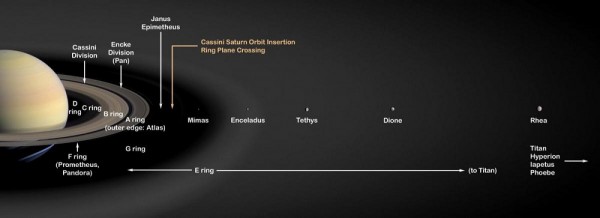By Ana Verayo, | March 27, 2016

Saturn's moon Rhea and all other moons and rings closer to Saturn may be only 100 million years old. Outer satellites (not pictured here), including Saturn's largest moon Titan, are probably as old as the planet itself.
Astronomers say that Saturn's icy moons along with its famous rings could apparently be younger than first thought, only at 100 millions years old, suggesting that they were first created during the age of dinosaurs.
The rings of Saturn were first detected during the 1600s as scientists argued about the real age of Saturn's moons and rings. In order to estimate their age, researchers relied on computer models to determine the moon's dynamic behavior in the past. They then compared this data to the orbital tilt predictions by computer simulations in order to learn more about the evolving orbits of Saturn's moons.
Like Us on Facebook
After much analysis, scientists reveal that the most important moons such as Tethys, Dione and Rhea, possess orbits that were not dramatically altered than first thought, suggesting that they did not encounter any orbital disturbances, which also means that they must have originally formed from somewhere not far their present orbit, making tham younger than previously thought.
According to principal investigator, Matija Cuk from the SETI Institute, along with the team from Southwest Research Institute, moons are always changing their orbits which is inevitable. Cuks says that this fact allowed them to utilize computer simulations to extract Saturn's history of its inner moons, and this data revealed that these moons were created during the recent two percent of the planet's entire existence.
Traditionally, it has been thought that Saturn's rings are as old as the giant, gas planet itself however, this changed when astronomers discovered in 2012 about the tidal effects of the moons or the interaction of the inner moons with the fluids on Saturn's interior that are causing them to spiral faster into a larger orbit radius. With this in mind, their current positions reveal that the moons and the rings are not so old.
In order to determine their exact age, Cuk and his team analyzed data from NASA's Cassini's mission and observed the ice geysers on Enceladus, one of Saturn's major moons.
As scientists base this energy directly coming from tidal interactions to these geysers, this means that the geothermal activity on Enceladus can be estimated to be constant, which also suggests that the tides within Saturn are also quite powerful. This means that Enceladus' age is more or less about 100 million years based on the simulations.
The major moons of Saturn except for the distant Titan and Iapetus are now estimated to form during the recent Cretaceous period, when dinosaurs walked the Earth.
Cuks says that the next step in this study is to investigate what caused this recent birth of these moons, leading to theories such as colliding with neighboring moons as they crossed with different orbits where this rubble formed Saturn's rings and moons. This new study is published in the Astrophysical Journal.
-
Use of Coronavirus Pandemic Drones Raises Privacy Concerns: Drones Spread Fear, Local Officials Say

-
Coronavirus Hampers The Delivery Of Lockheed Martin F-35 Stealth Fighters For 2020

-
Instagram Speeds Up Plans to Add Account Memorialization Feature Due to COVID-19 Deaths

-
NASA: Perseverance Plans to Bring 'Mars Rock' to Earth in 2031

-
600 Dead And 3,000 In The Hospital as Iranians Believed Drinking High-Concentrations of Alcohol Can Cure The Coronavirus

-
600 Dead And 3,000 In The Hospital as Iranians Believed Drinking High-Concentrations of Alcohol Can Cure The Coronavirus

-
COVID-19: Doctors, Nurses Use Virtual Reality to Learn New Skills in Treating Coronavirus Patients







